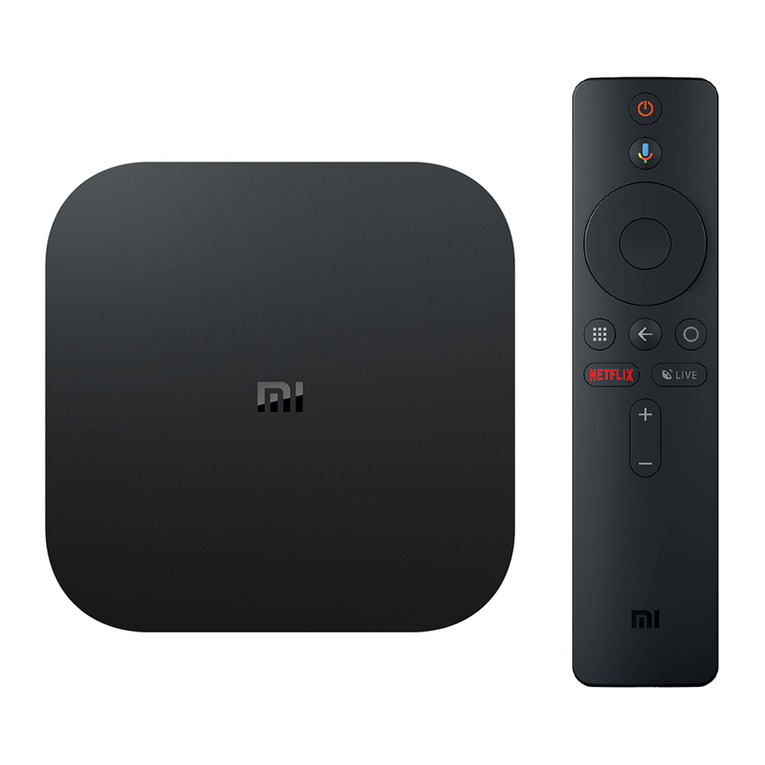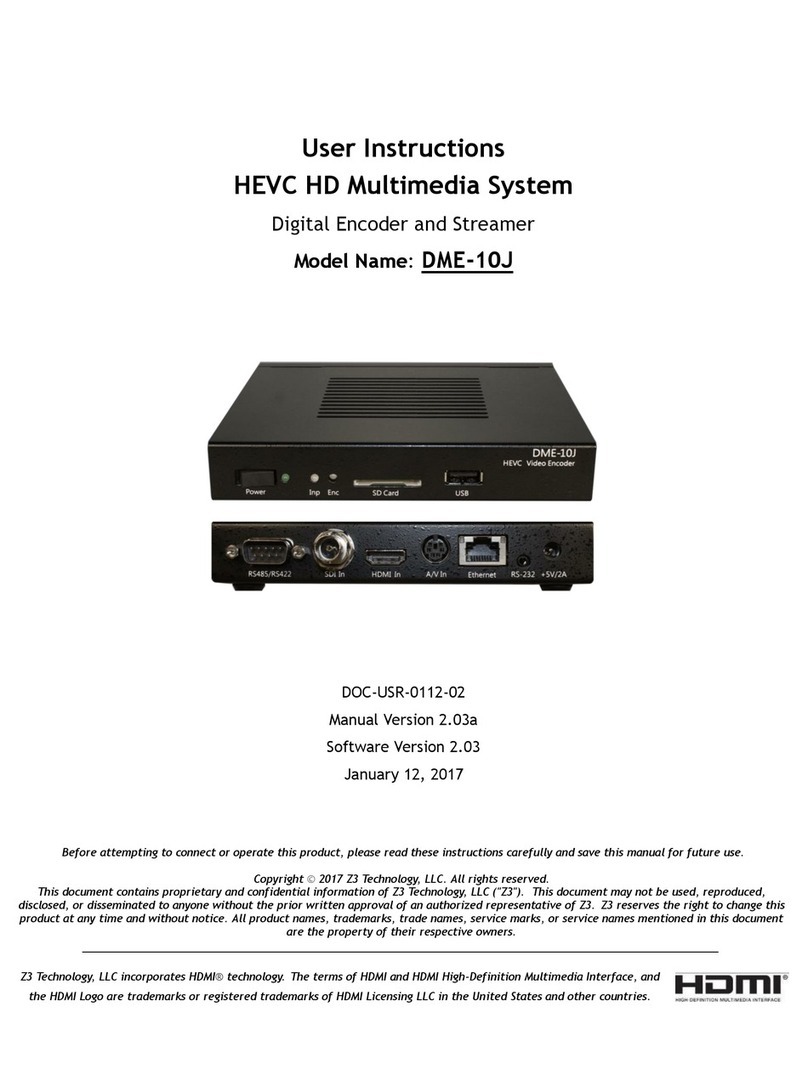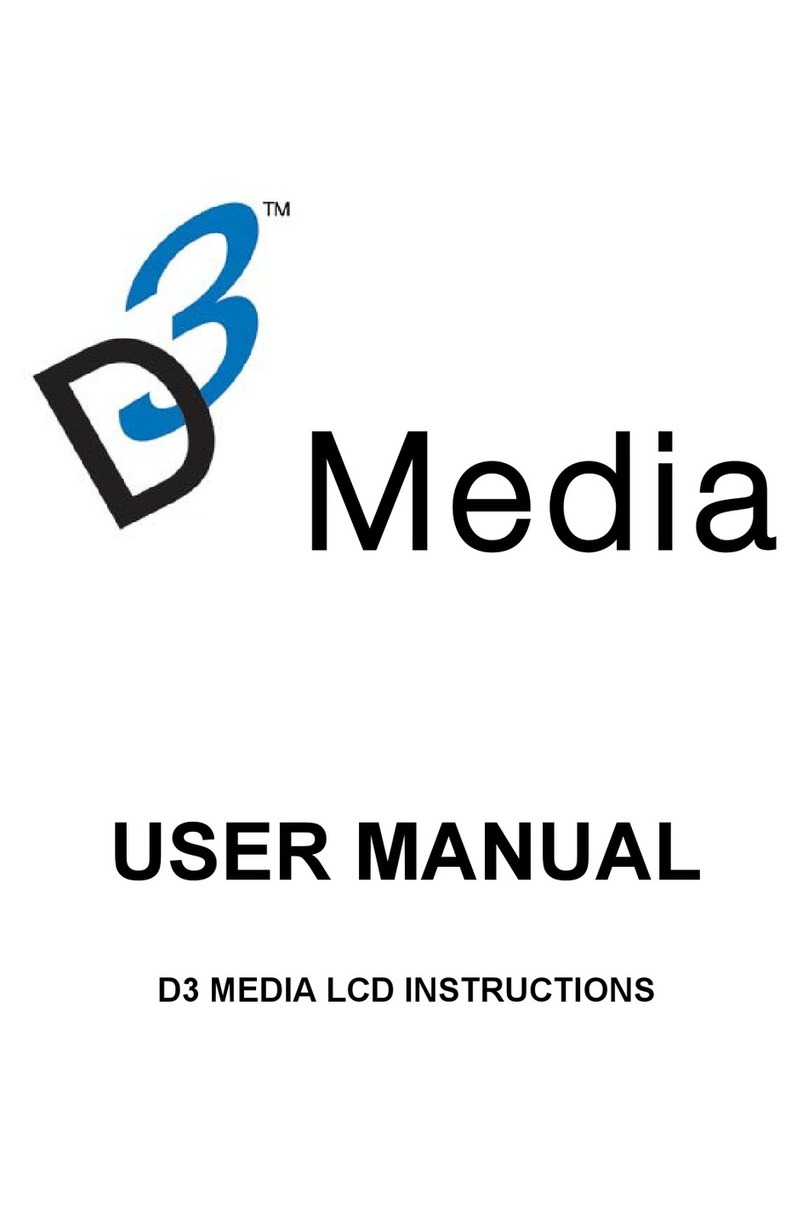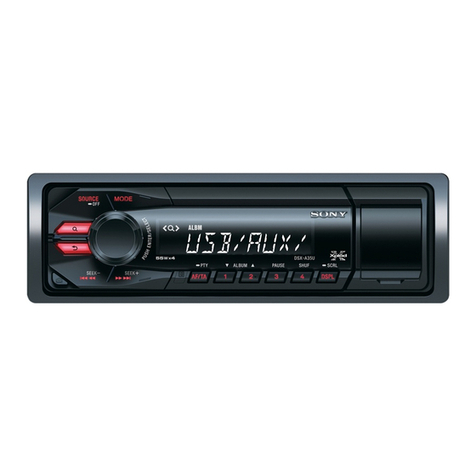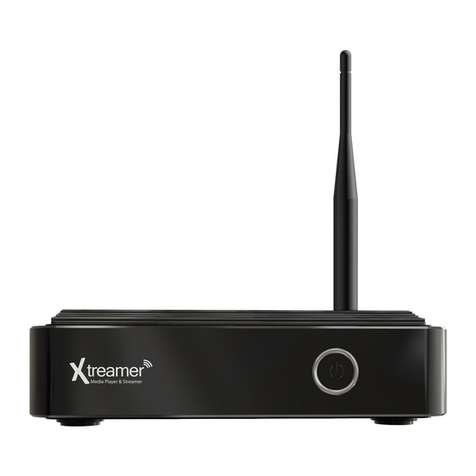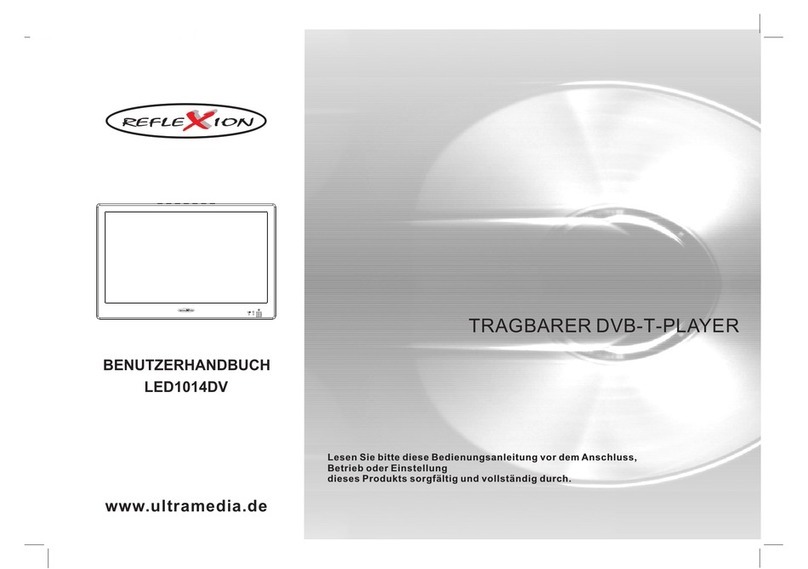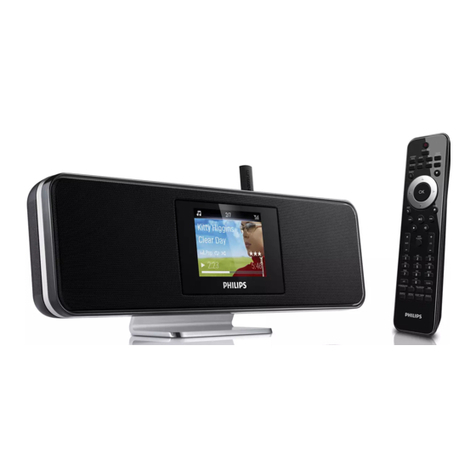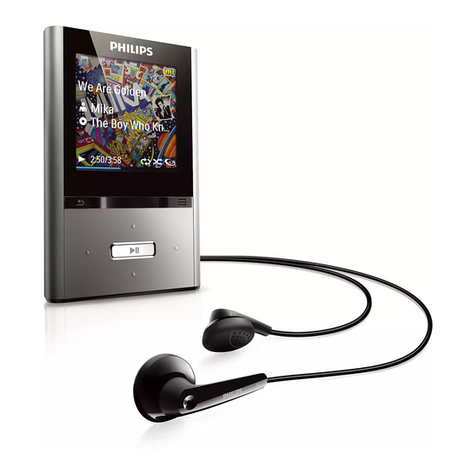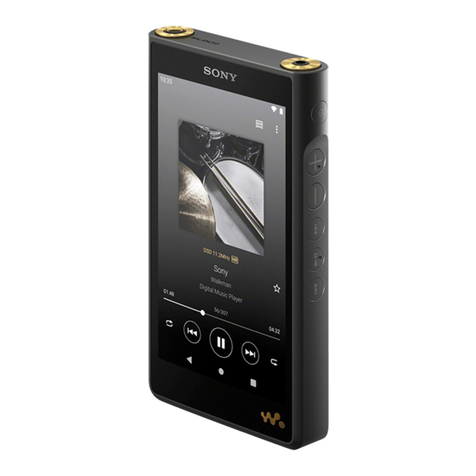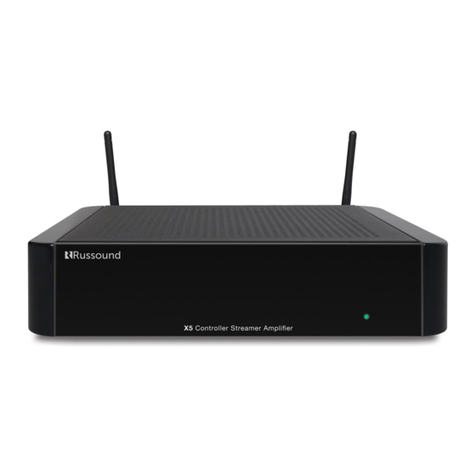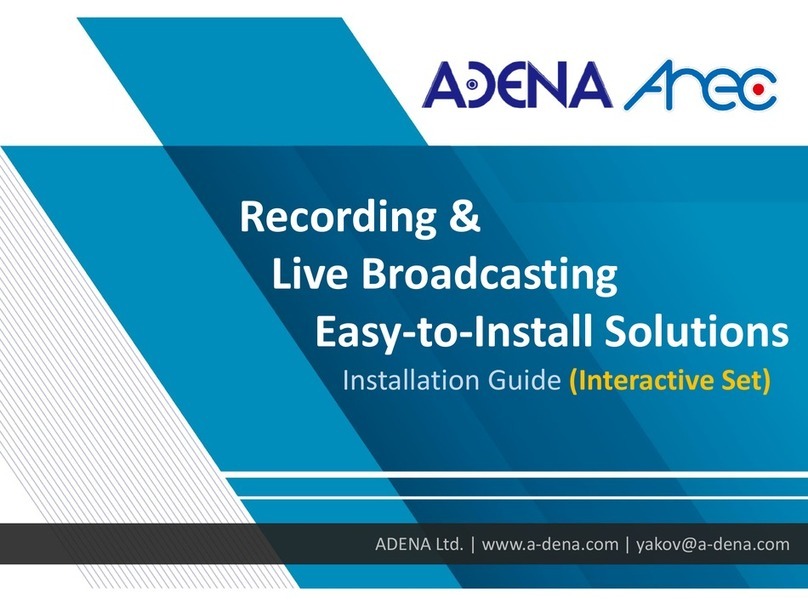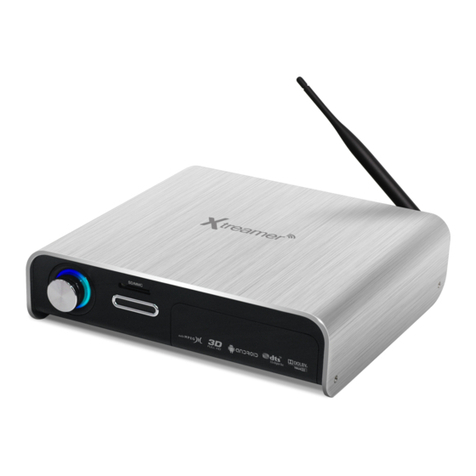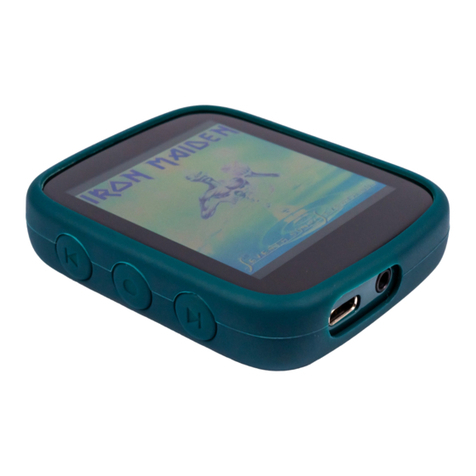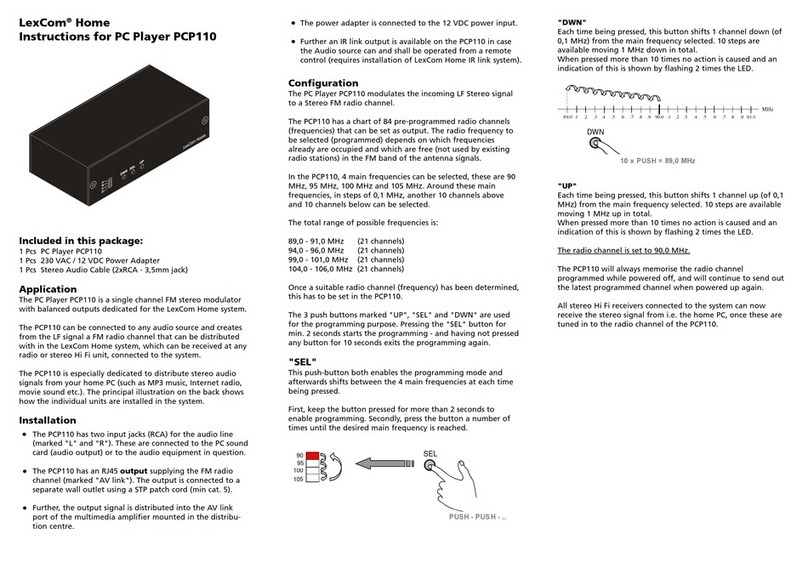Bricasti Design M5 User manual

M5 Network Player
User Guide
5/17 Preliminary


Conformity
EMC / EMI
This equipment has been tested and found to comply with the limits for a Class B digital device, pursuant
to part 15 of the FCC rules. These limits are designed to provide reasonable protection against harmful
interference in residential installations.
Canadian Customers
This Class B digital apparatus complies with Canadian ICES-003.
Cet appareil numerous de la classe B est conforme a la norme NMB-003 du Canada.
Certificate Of Conformity
Bricasti Design, 123 Fells Ave., Medford MA, USA, hereby
declares on its own responsibility the following products:
M5
-that is covered by this certificate and marked with the CE-label
conforms to the following standards:
EN 60065 Safety requirements for mains operated electronic
and related apparatus for household and general
use
EN 55103-1 Product family standard for audio, video,
audiovisual and entertainment lighting control
apparatus for professional use. Part 1: Emission
EN 55103-2 Product family standard for audio, video,
audiovisual and entertainment lighting control
apparatus for professional use. Part 2: Immunity
With reference to the regulations in the following directives:
73/23/EEC, 89/336/EEC
January 2017
Brian S Zolner
President

Introduction
This edition of the M5 user guide covers theory of design, setup and use. In the future you can always find
the latest version available at our web site www.bricasti.com.
Congratulations on the purchase of your new M5 Network Player. We at Bricasti Design have set out to
design the world’s finest audio products made for the professional and consumer audio markets and the M5
joins with our other highly regarded products in our product line.
Network Audio
The M5 Network Player provides the user with the ability to take any DAC, like our M1 and get it
connected to a high quality audio network via Ethernet or Wi-Fi and connect to your DAC without using
USB. This uncompromising designed renderer is based on our M12 source controller which has this
feature built in, and now available in the M5 as a complete stand-alone product. When combined with our
M1 or any other DAC the M5 will take digital to a new level of uncompromising clarity.
Build Quality
The M5 is robustly constructed of milled and CNC machined aluminum sections. There is no typical bent
metal chassis and top cover found on most products. All sections of the construction, the front and rear
panels, the sides and even the bottom and top plates start out as solid blocks of aluminum which are
precision machined to shape, with exact tolerances for a perfect fit. These parts are then anodized and the
text and markings are laser etched for a clean and enduring look.
The Sound
The intention of the M5 is to provide state of the art playback and transfer of digital audio data from your
network attached drive or anywhere on the network the audio is stored. In this scheme the audio is then
“rendered” or streamed as real-time audio in the M5, then sent to the passive digital outputs, the AES or
SPDIF. This approach removes the host server computer from the actual playing of the audio and
eliminates typical issues found, such as noise generated from PC power supplies and switch mode voltage
regulators in the computer, plus noise from power over USB when using a computer for this purpose.
The result is quiet backgrounds, clear transients, and the elimination of noise and power contamination as
the M5 has a fully linear power supply. Even the USB playback from the M5 will be an improvement over
a normal PC, as all the power running the USB is directly from our linear supply with no switch mode
regulators to create high frequency noise. We hope you find the M5 to be pleasing and enjoyable to hear
and use in the home, or as a precision tool for high level reference monitoring for the professional.

Unpacking and Inspection
After unpacking the M5 save all packing materials in the event you ever need to ship the unit. Thoroughly
inspect the M5 and packing materials for any signs of damage in shipment. Report any damage to the
carrier at once.
Precautions
The Bricasti Design M5 is a rugged device with extensive electrical protection. However, reasonable
precautions applicable to any piece of audio equipment should be observed.
Always use the correct AC line voltage as set by the manufacturer. Refer to the power requirements
section of the manual and adhere to any power indications on the rear or bottom of the chassis. Using
the incorrect AC line voltage can cause damage to your M5, so please check this carefully before
applying power.
Do not install the M5 in an unventilated rack or directly above any heat-producing equipment.
Maximum ambient operating temperature is 40 C.
To prevent fire or shock hazard, do not expose the M5 to rain or moisture.
Notices
In the interest of continued product development, Bricasti Design reserves the right to make improvements
to this manual and the product it describes at any time and without notice.
Copyright 2017
Bricasti Design LTD
123 Fells Ave
Medford MA 01255 USA
781 306 0420
bricasti.com
All Rights Reserved
This publication is protected by copyright and all rights are reserved.
1

Important Safety Instructions:
Notice!
Read these instructions.
Keep these instructions.
Heed all warnings.
Follow these instructions.
Do not use this apparatus near water.
Clean only with dry cloth.
Do not block ventilation openings; install
in accordance with manufacturer’s
instructions.
Do not install near any heat sources such
as radiators, heat registers, stoves, or other
apparatus (including amplifiers, pre amps)
that produce heat.
Do not defeat the safety purpose of the
polarized or grounded type plug. A
polarized plug has two blades with one
wider than the other. A grounding type
plug has two blades and a third grounding
prong. The wide blade and prong are for
your safety. If the provided plug does not
fit in your outlet, consult an electrician for
replacement of the obsolete outlet.
Protect power cord from being walked on
or pinched.
Use only attachments/accessories
specified by the manufacturer.
Unplug this apparatus during lightning
storms or when unused for long periods of
time.
Refer all servicing to qualified service
personnel. Service is required when the
apparatus has been damaged in any way,
such as by being dropped, exposed to rain,
liquid being spilled on it, or otherwise
does not operate normally.
Service
There are no user serviceable parts inside.
All service must be performed by
qualified personnel.
Warning!
To reduce the risk of fire or electrical
shock do not expose this equipment to
dripping or splashing water and ensure
that no objects such as vases are placed on
the equipment.
This apparatus must be earthed.
This equipment requires the correct AC
line voltage as set by the manufacture
and is not auto sensing or scaling.
Use a three-wire grounding-type line cord
like the one supplied with this product.
Be aware that different operating voltages
require the use of different types of line
cords and attachment plugs.
Check the voltage in your area and use the
correct type. See table below:
Voltage
Line plug standard
110-125V
UL817 and CSA C22.2 no 42
220-230V
CEE 7 page VII, SR section 107-
2-D1/IEC 83 pg C4
240V
BS 1363 of 1984
Specification for 13A fused
plugs and switched and
unswitched outlet plugs
This equipment should be installed near
the socket outlet and disconnection of the
device should be easily accessible.
To completely disconnect from AC mains,
disconnect the power supply cord from
the AC receptacle.
Do not install in a confined space.
Do not open the unit -risk of electrical
shock inside.
Caution
You are cautioned that any change or
modification not expressly approved in
this manual could void your authority to
operate this equipment.
2

M5 Operational Overview
Front Panel
The front panel has 1 button and an LED. The primary power on/off is found on the rear panel, and on the
front there is a standby button and LED to indicate status of the M5. The M5 will power on in stand-by,
this is an idle mode with low power consumption, full power is then applied when pressing the stand-by
button.
Rear Panel
At the rear starting at the right in the picture you will find the XLR connector for the balanced AES output,
RCA connector for SPDIF out and the USB which can be used as a digital audio out or Wi-Fi network
input.
Next are the trigger in and out connectors which are used to set the M5 in and out of standby from a
preamp or our M12 source controller. Above is the RJ45 Ethernet connector and to the far left is the AC
inlet and main power on off switch.
3

Setup and Operation
Important Safety Note about AC power and the M5
The AC power is connected at the rear of the unit IEC type switched AC inlet with standby switch setting
on the front panel. This is a filtered inlet and helps provide clean AC power to the M5’s power supply and
will prevent any RF and noise from entering M5 power grid. Take note that because the M5 utilizes a
linear power supply and care should be taken to use only the power range indicated on the unit, otherwise
damage may occur to the power supply and other circuits in the M5. Please note and adhere to any voltage
indications on the outer box, rear panel or chassis all of which will indicate how the M5 is set at
manufacturer.
Making Connections to the M5
Ethernet Network Connection
Before powering on the M5, connect the network to RJ45 with a suitable Cat5 cable assembly to your
router, there are no practical distance limitations with Ethernet so the server can be located away from your
listening room providing you with a quiet listening environment from computer and disk drive acoustical
noise. Your server should also be connected to the same router as creating a network and not a point to
point interface like USB. For best sound and reliability we recommended connecting the M5 with a wired
connection to your router with a suitable Cat 5 cable.
Wi-Fi Network Connection
For convince the M5 can also use Wi-Fi for its network connection. This is done by using the USB
connector at the rear panel. For the purest, this allows the M5 to be used without wifi and eliminate and
concerns about Wi-Fi, and for one who prefers or needs the convenience, the Wi-Fi can be added.
To implement this connection the M5 is provided with a small USB Wi-Fi dongle. When this is placed in
the USB connector and the M5 is powered on it will default and use the Wi-Fi for its network interface. As
noted in with the wired Ethernet example above its best to have your server up and running before starting
the M5 so the server app can find it. To enable the wireless connection you first have to have the M5
connected to your router with Ethernet, this can be done next to the router with a short cable. You then go
to your server computer, open the network sharing device menu, click on the M5 device icon. This will
open your web browser where you will then be able to configure the M5 with your Wi-Fi password and
name as with other wireless devices. Once this is setup you can then move the M5 to your desired location
and power up with the Wi-Fi dongle installed in the USB connector at the rear panel.
The performance of the Wi-Fi will depend on the signal strength with your router; you may have to use a
USB extender cable to get the Wi-Fi USB dongle antenna away from other products and the M5 chassis as
they may block the signal. For best sound and reliability we recommended connecting the M5 with a
wired connection to your router with a suitable Cat 5 cable.
4

Digital Audio Connections
We recommend the use of high quality balanced AES 10ohm XLR cables when using the AES outputs and
75ohm coaxial cable for the unbalanced RCA SPDIF output.
The M5 can play digital audio data out of the AES and SPDIF simultaneously, so both can be connected to
your DAC or 2 DACs and play out at the same time. But, it will not play to the AES and SPDIF
simultaneously with USB output activated; it works with one or the other. To activate the USB, power up
with USB connected to your DAC and the M5 will default to use the USB outputs, in this case the AES and
SPDIF will not function. To switch back you must power off, remove the USB cable from the M5, power
on and it will then use the AES and SPDIF outputs.
AC power
The M5 is supplied with a high quality power AC cord tipped with a 10-amp IEC connector that meets all
safety requirements. You may use different power cord with the M5 providing it meet or exceeds all safety
requirements noted elsewhere in this manual. Note that the M5 utilizes a linear power supply so adhere to
all power indications on the outer box, and rear of the unit. Do not apply the incorrect voltage to the M5,
this will damage the power supply and render the M5 unusable.
Power Up
Once all your cables are connected to the M5 it is time to power up. We recommend that your server and router be
up and running before starting the M5. Our experience shows that this is a more reliable method for the M5 to
communicate with the network and server application that is looking for it as a DNLA or Roon compatible device.
In some cases, depending on the sequence of events, it may take time for this to connect, but when the server is up
and ready it will connect in a few minutes. This is indicated on the front panel LED, when the M5 is connected it
will then light on solid and stop flashing.
Power Up Sequence
Stand-By Mode:
The M5 has a dedicate AC mains power switch found on the rear of the unit, when first powering the M5
on from the rear panel the M5 will enter into stand by. The front panel LED will be blinking with a quick
short blink to indicate power is on but waiting. This is a low current mode and only the power supply is
ready but no current is drawn from the processors.
Run Mode
Next press the stand by button and the LED will now change to a faster rate of change indicating boot up of
the processor and searching for a valid network connection. Once this is complete, about 10 sec, the LED
will be on solid indicating successful boot up and valid network connection. The M5 should now appear in
your media player or server as an available device to play to. If not then there is an issue with the network
connection and server.
Placing the M5 Back to Standby
A quick press of the standby key from the running state will set the M5 into STANDBY mode, and the
front panel LED will be flashing at the 1/3 speed, the processor will be shut down and the M5 will remain
in low current mode. If desired you can fully power off the M5 from the rear panel AC in let switch, in this
cases when powering back up you will have to repeat the above sequence as it will power back up into
stand by.
5

Trigger In/Out:
The rear panel the M5 has 2 stereo connectors (Tip/Ring/Sleeve) for triggering the M5 into standby mode
from an external device like a preamp or other external remote control. Sleeve is connected to chassis
ground, Tip/Ring is the input +/-. The M5 will go in and out of standby when it has a positive 5V or 12V
DC voltage between tip/ring, this system is implemented on our M12 source controller. The trigger out is a
repeat of the trigger in voltage for easy daisy chain connections to another device like the M15 power amp.
Audio Specs and sample rates supported:
AES Output: 44.1kHz-192 kHz PCM and DSD 64 as DoP, Wi-Fi or Ethernet
SPDIF Output: 44.1 kHz-192 kHz PCM and DSD 64 as DoP, Wi-Fi or Ethernet
USB Output: 44.1 kHz-384 kHz PCM and DSD 64 and 128 as DoP, Ethernet only
Applications Supported:
The network audio player or what is also called a renderer is DNLA, UnPN and ROON compatible, so any
application that supports these protocols will recognize and “see “ the M5 as an device on the network to play to.
The M5 is not a server, but a player or end point. The audio is rendered in the M5 and not in the server and this is
the important difference when using the M5 in a networked setup, as the actual audio can be stored on any storage
device on the network. We recommend Jriver Media Center for the PC and Mac, and Roon as the popular
applications that support DNLA and of course Roon.
6

General Specifications
EMC
Complies with: EN 55103-1 and EN 55103-2 FCC part 15, Class B
RoHS
Complies with: EU RoHS Directive 2002/95/EC
Safety
Certified to: IEC 60065, EN 55103-2
Environment
Operating Temperature: 32 F to 105 F (0 C to 40 C)
Storage Temperature: -22 f to 167 F (-30 C to 70 C
General
Finish: Anodized Aluminum
Dimensions: 8” wide, 2” high, 8.5” deep
Weight: 5 lbs
Shipping Weight: 8 lbs
Mains Voltage set at factory: 100, 120, 220, 230, 240 VAC, 50 Hz –60 Hz
Trigger In: TRS connector for 5V external trigger.
Power consumption: 1W standby, 5W running
Warranty parts and labor: 5 yrs limited
M5 Limited Warranty
Bricasti Design warrants the M5 against manufacturing defects for 5 years from date of purchase from an authorized
Bricasti Design dealer.
1. The warranty covers only new products purchased from a Bricasti Design dealer or Distributor.
2. The warranty is nontransferable, valid for the original purchaser.
3. All service must be performed by an authorized Bricasti Design Dealer or Distributor
4. For USA customers, if the product is shipped back to Bricasti Design for warranty service, the customer
pays for inbound shipping costs and Bricasti Design will pay for the return shipping.
5. Customer must provide proof of purchase to be eligible for warranty service.
6. All international customers must contact their local distributor for service.
7

Copyright 2017- Bricasti Design Ltd.-2 Shaker RD,- Shirley MA 01464 USA
Table of contents
